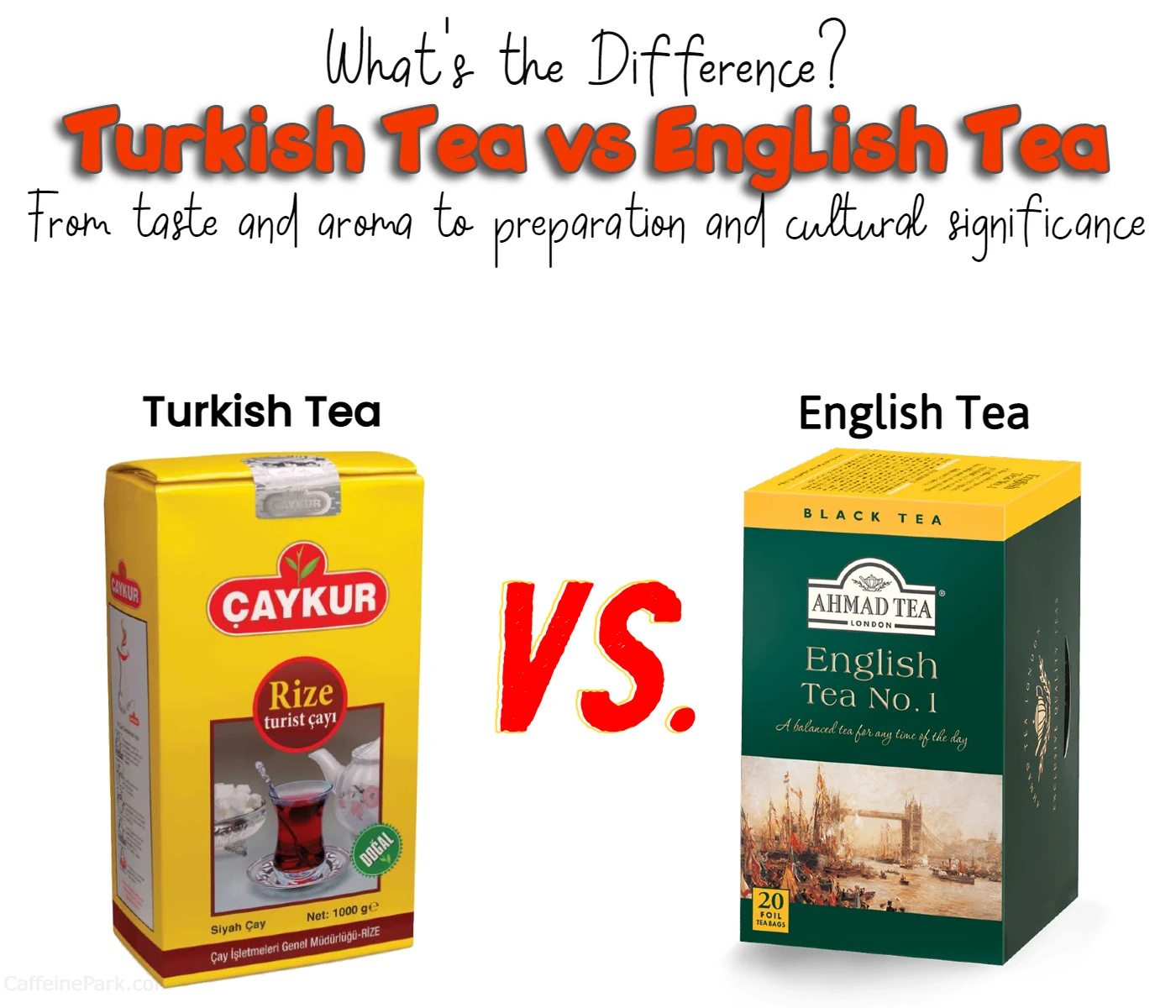
Tea is more than just a beverage; it’s a cultural staple that varies greatly across the world. While many countries have their own unique takes on tea, two that stand out are Turkish tea and English tea. Both are steeped in rich history and cultural significance, but they couldn’t be more different in terms of taste, aroma, and preparation.
If you’re a tea lover like me, then you might be curious about the differences between Turkish tea and English tea. For starters, Turkish tea is known for its light, delicate flavor that’s slightly bitter and tannic. It’s typically served on its own without milk or sugar, and it’s brewed in a special teapot called a çaydanlık. On the other hand, English tea is all about bold, full-bodied flavors that are often enjoyed with milk and sugar. It’s traditionally brewed in a teapot with boiling water and served in teacups with a strainer.
So, if you’re looking to explore the wonderful world of tea, then I invite you to read on and learn more about the unique characteristics of Turkish tea and English tea. By the end of this article, you’ll have a deeper understanding of these two beloved beverages and the cultural significance that they hold. Let’s dive in!
Here’s a quick chart summarizing the differences between Turkish tea and English tea:
| Turkish Tea | English Tea | |
|---|---|---|
| Preparation | Two-tiered teapot, small glasses | Teapot, teacups with milk and sugar |
| Taste | Milder | Stronger and more robust |
| Serving | Black, often with sugar | Often with milk and sugar |
| Health benefits | Contains antioxidants that may reduce the risk of heart disease and stroke | Contains antioxidants that may improve heart health, reduce the risk of stroke, and aid in digestion |
| Cultural significance | Symbol of hospitality, friendship, and socializing in Turkish culture | Teapots, teacups with milk and sugar |
Differences between Turkish tea and English tea
History and Culture
Both Turkish tea and English tea have a rich history and culture behind them. Tea was introduced to England in the mid-17th century and quickly became a popular beverage. The British East India Company played a significant role in bringing tea to England. The tradition of drinking tea in England is accompanied by a variety of customs and rituals, such as afternoon tea, which is a formal occasion where tea is served along with sandwiches and pastries.
On the other hand, Turkish tea has a much longer history, dating back to the Ottoman Empire in the early 16th century. The tradition of drinking tea in Turkey is deeply ingrained in the country’s culture and is a central part of daily life. Turkish tea is often served in small glasses, and the preparation of tea is accompanied by a range of customs and rituals, such as using a traditional two-tiered teapot and serving the tea with a cube of sugar.
Preparation
The preparation of Turkish tea and English tea differs significantly. In England, tea is usually made using tea bags, which are readily available in supermarkets. The tea is brewed in a teapot with boiling water for 3-5 minutes, depending on the strength of the tea desired. Milk and sugar are often added to the tea to taste.
Turkish tea, on the other hand, is made using a special two-tiered teapot called a “çaydanlık.” The lower tier is filled with boiling water, and the upper tier is filled with loose tea leaves. The tea is brewed by placing the upper tier on top of the lower tier, and the tea is allowed to steep for 10-15 minutes. The tea is then served in small glasses, and sugar is often added to taste.
Taste
The taste of Turkish tea and English tea is quite different. English tea is typically a blend of black tea leaves, which gives it a strong, robust flavor. The addition of milk and sugar can also significantly alter the taste of the tea.
Turkish tea, on the other hand, is usually made using a blend of black tea leaves and has a much milder taste compared to English tea. The tea is often served with a cube of sugar, which helps to bring out the tea’s natural sweetness.
Presentation
The presentation of Turkish tea and English tea also differs significantly. In England, tea is usually served in a teapot and poured into teacups, often accompanied by milk and sugar. Afternoon tea is often served with sandwiches, scones, and pastries.
In Turkey, tea is traditionally served in small, tulip-shaped glasses. The glasses are usually filled to just below the brim, and the tea is often served with a cube of sugar on the side. The presentation of Turkish tea is an integral part of the tea-drinking experience and is accompanied by a range of customs and rituals.
Health Benefits
Both Turkish tea and English tea have potential health benefits due to the antioxidants found in tea leaves. However, the health benefits of these teas may differ slightly.
English tea is often black tea, which has been shown to have potential health benefits such as improving heart health, reducing the risk of stroke, and aiding digestion. The milk often added to English tea may also provide additional health benefits, such as calcium and vitamin D.
Turkish tea is also made using black tea leaves, which contain antioxidants that may have potential health benefits, such as reducing the risk of heart disease and stroke. However, drinking tea with sugar may offset some of the potential health benefits, and excessive sugar consumption can have negative health consequences.
Overall, both Turkish tea and English tea can be enjoyed in moderation as part of a healthy lifestyle. It’s essential to consider the potential health benefits and drawbacks of each type of tea and adjust consumption accordingly.
Cultural Significance
Both Turkish tea and English tea hold significant cultural significance in their respective countries. Drinking tea is an essential part of Turkish culture and is a symbol of hospitality, friendship, and socializing. Turkish tea is often served in homes, offices, and cafes throughout the day, and tea breaks are an important part of daily life.
Similarly, tea drinking is also an important part of English culture and is often associated with socializing and relaxation. Afternoon tea is a formal occasion that is often enjoyed with friends or family, and tea breaks are a common occurrence in the workplace.
In both cultures, drinking tea is not just about consuming a beverage; it’s about socializing and connecting with others. The traditions and customs surrounding tea drinking have been passed down through generations and continue to be an essential part of daily life.
Conclusion
In conclusion, the differences between Turkish tea and English tea are significant and reflect the unique cultures and traditions surrounding tea in each country. Turkish tea is often served in small glasses and made using a special two-tiered teapot, while English tea is brewed in a teapot and often served in teacups with milk and sugar. The taste, preparation, and presentation of these teas also differ, with Turkish tea being milder in flavor and served in smaller glasses.
Despite these differences, both Turkish tea and English tea hold significant cultural significance in their respective countries and are enjoyed by millions of people around the world. Whether it’s sharing a cup of tea with friends, enjoying a tea break at work, or savoring a cup of tea with a pastry, tea drinking is an essential part of daily life in many cultures and will continue to be cherished for generations to come.
Alternative to English tea and Turkish tea
If you’re looking for an alternative to English tea and Turkish tea, there are many different types of tea from around the world that you can try. Here are a few suggestions:
- Japanese Green Tea: Japanese green tea is known for its light, refreshing taste, and high antioxidant content. It is often served in traditional Japanese tea ceremonies and is a popular drink in Japan.
- Indian Chai Tea: Chai tea is a popular drink in India and is made with black tea, spices, and milk. It has a rich, spicy flavor and is often sweetened with honey or sugar.
- Chinese Oolong Tea: Oolong tea is a type of Chinese tea that is partially fermented, giving it a unique flavor that is somewhere between black and green tea. It is often served in small cups and has a slightly floral, nutty flavor.
- Moroccan Mint Tea: Moroccan mint tea is a traditional drink in Morocco and is made with green tea, fresh mint, and sugar. It has a refreshing, sweet flavor and is often served with Moroccan pastries.
- South African Rooibos Tea: Rooibos tea is a caffeine-free tea made from the leaves of the South African rooibos plant. It has a mild, slightly sweet flavor and is often served as a bedtime tea due to its lack of caffeine.
There are many other types of tea from around the world to explore, each with its own unique flavors and cultural traditions.
FAQs
The main difference is the way they are prepared and served. Turkish tea is prepared using a special two-tiered teapot and served in small glasses, while English tea is brewed in a teapot and served in teacups with milk and sugar.
Yes, there is a difference in taste. Turkish tea is milder in flavor compared to English tea, which is often stronger and more robust.
Both Turkish tea and English tea have potential health benefits due to the antioxidants found in tea leaves. However, the health benefits of these teas may differ slightly. English tea is often black tea, which has been shown to have potential health benefits such as improving heart health, reducing the risk of stroke, and aiding digestion. Turkish tea is also made using black tea leaves, which contain antioxidants that may have potential health benefits, such as reducing the risk of heart disease and stroke. However, drinking tea with sugar may offset some of the potential health benefits, and excessive sugar consumption can have negative health consequences.
Both Turkish tea and English tea are popular in their respective countries, and both have their unique cultures and traditions surrounding tea. In Turkey, tea is an essential part of daily life and is often served in homes, offices, and cafes throughout the day. Similarly, tea drinking is an important part of English culture and is often associated with socializing and relaxation. Afternoon tea is a formal occasion that is often enjoyed with friends or family, and tea breaks are a common occurrence in the workplace.
Read More:





